Paper Menu >>
Journal Menu >>
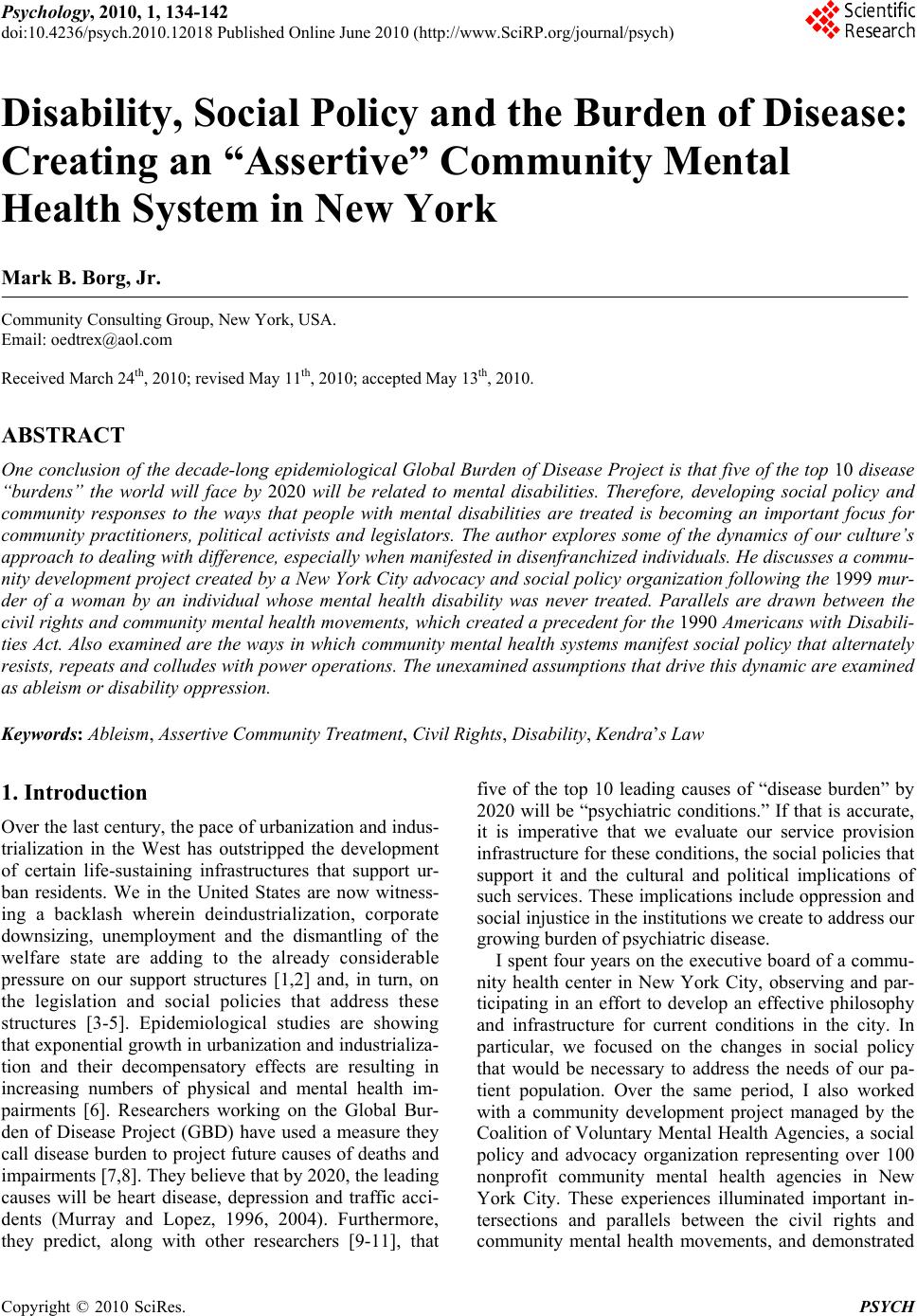 Psychology, 2010, 1, 134-142 doi:10.4236/psych.2010.12018 Published Online June 2010 (http://www.SciRP.org/journal/psych) Copyright © 2010 SciRes. PSYCH Disability, Social Policy and the Burden of Disease: Creating an “Assertive” Community Mental Health System in New York Mark B. Borg, Jr. Community Consulting Group, New York, USA. Email: oedtrex@aol.com Received March 24th, 2010; revised May 11th, 2010; accepted May 13th, 2010. ABSTRACT One conclusion of the d ecade-long epidemiological Global Burden of Disease Pro ject is that five of the top 10 disease “burdens” the world will face by 2020 will be related to mental disabilities. Therefore, developing social policy and community responses to the ways that people with mental disabilities are treated is becoming an important focus for community practitioners, political activists and legislators. The author explores some of the dynamics of our culture’s approach to dealing with d ifference, especially when manifested in disenfra nchized individuals. He d iscusses a commu- nity development project created by a New York City advocacy and social policy organization following the 1999 mur- der of a woman by an individual whose mental health disability was never treated. Parallels are drawn between the civil rights and community mental health movements, which created a precedent for the 1990 Americans with Disabili- ties Act. Also examined are the ways in which community mental health systems manifest social policy that alternately resists, repeats and colludes with po wer operations. Th e unexamin ed assumptions tha t drive this dynamic are exa mined as ableism or disability oppression. Keywords: Ableism, Assertive Community Treatment, Civil Rights, Disability, Kendra’s Law 1. Introduction Over the last century, the pace of urbanization and indus- trialization in the West has outstripped the development of certain life-sustaining infrastructures that support ur- ban residents. We in the United States are now witness- ing a backlash wherein deindustrialization, corporate downsizing, unemployment and the dismantling of the welfare state are adding to the already considerable pressure on our support structures [1,2] and, in turn, on the legislation and social policies that address these structures [3-5]. Epidemiological studies are showing that exponential growth in urban ization and indus trializa- tion and their decompensatory effects are resulting in increasing numbers of physical and mental health im- pairments [6]. Researchers working on the Global Bur- den of Disease Project (GBD) have used a measure they call disease burden to project future causes of deaths and impairments [7,8]. Th ey believe that by 2020, th e leading causes will be heart disease, depression and traffic acci- dents (Murray and Lopez, 1996, 2004). Furthermore, they predict, along with other researchers [9-11], that five of the top 10 leading causes of “disease burden” by 2020 will be “psychiatric conditions.” If that is accurate, it is imperative that we evaluate our service provision infrastructure for th ese condition s, the social policies that support it and the cultural and political implications of such services. These implications include oppression and social injustice in the institutions we create to address our growing bu rde n of psychiatric disease. I spent four years on the executive board of a commu- nity health center in New York City, observing and par- ticipating in an effort to develop an effective philosophy and infrastructure for current conditions in the city. In particular, we focused on the changes in social policy that would be necessary to address the needs of our pa- tient population. Over the same period, I also worked with a community development project managed by the Coalition of Voluntary Mental Health Agencies, a social policy and advocacy organization representing over 100 nonprofit community mental health agencies in New York City. These experiences illuminated important in- tersections and parallels between the civil rights and community mental health movements, and demonstrated 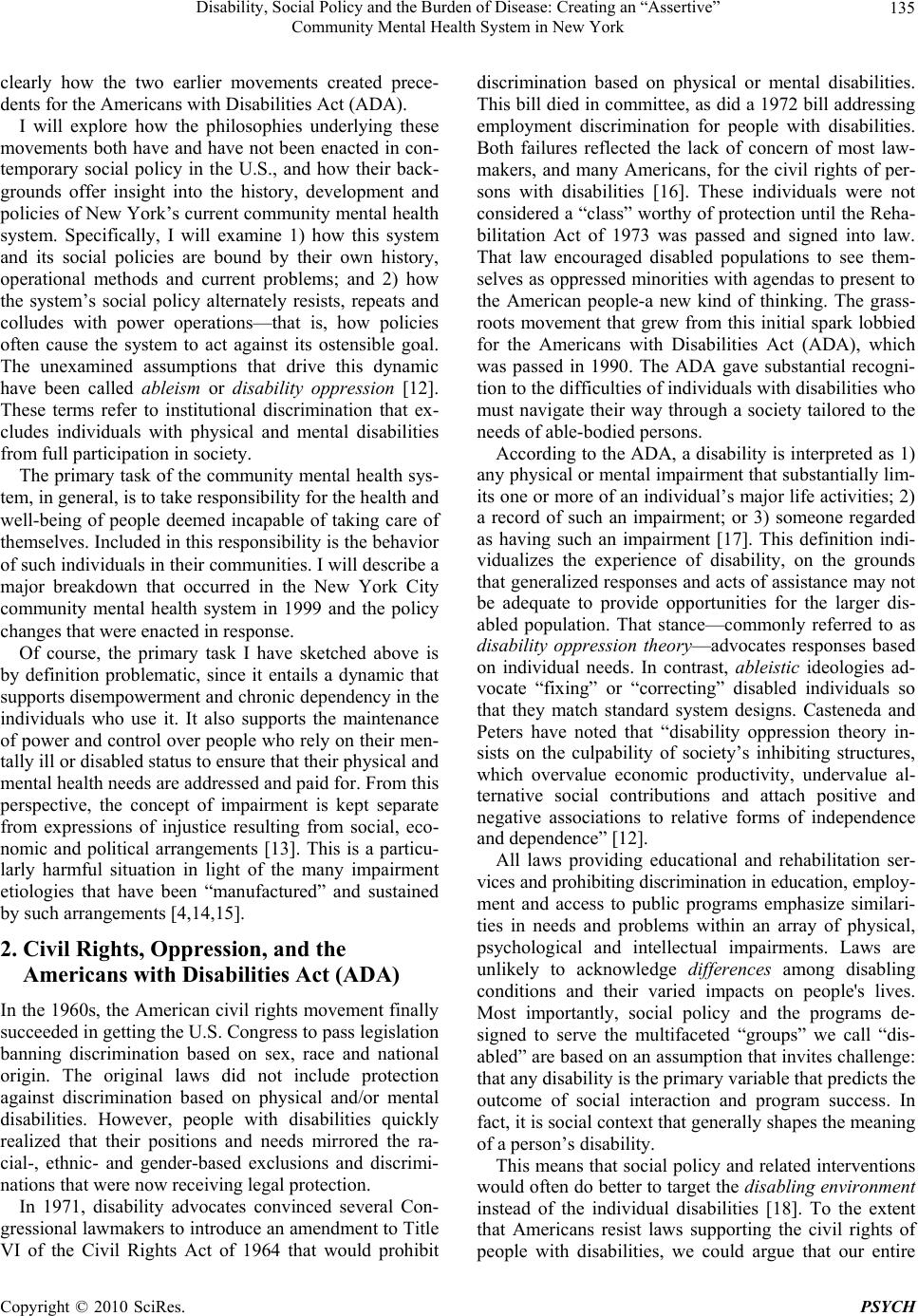 Disability, Social Policy and the Burden of Disease: Creating an “Assertive” 135 Community Mental Health System in New York clearly how the two earlier movements created prece- dents for the Americans with Disabilities Act (ADA). I will explore how the philosophies underlying these movements both have and have not been enacted in con- temporary social policy in the U.S., and how their back- grounds offer insight into the history, development and policies of New York’s current community mental health system. Specifically, I will examine 1) how this system and its social policies are bound by their own history, operational methods and current problems; and 2) how the system’s social policy alternately resists, repeats and colludes with power operations—that is, how policies often cause the system to act against its ostensible goal. The unexamined assumptions that drive this dynamic have been called ableism or disability oppression [12]. These terms refer to institutional discrimination that ex- cludes individuals with physical and mental disabilities from full participation in society. The primary task of the community mental health sys- tem, in general, is to take responsibility for the health and well-being of people deemed incapable of taking care of themselves. Included in this responsibility is th e behavior of such individuals in th eir communities. I will describ e a major breakdown that occurred in the New York City community mental health system in 1999 and the policy changes that were enacted in response. Of course, the primary task I have sketched above is by definition problematic, since it entails a dynamic that supports disempowerment and chronic dependency in the individuals who use it. It also supports the maintenance of power and control over people who rely on their men- tally ill or disabled statu s to ensure that their ph ysical and mental health needs are addressed and paid for. From this perspective, the concept of impairment is kept separate from expressions of injustice resulting from social, eco- nomic and political arrangements [13]. This is a particu- larly harmful situation in light of the many impairment etiologies that have been “manufactured” and sustained by such arrangements [4,14,15]. 2. Civil Rights, Oppression, and the Americans with Dis a bi li ti es A ct ( A DA ) In the 1960s, the American civil rights movement finally succeeded in getting the U.S. Congress to pass legislation banning discrimination based on sex, race and national origin. The original laws did not include protection against discrimination based on physical and/or mental disabilities. However, people with disabilities quickly realized that their positions and needs mirrored the ra- cial-, ethnic- and gender-based exclusions and discrimi- nations that were now receiving legal protection. In 1971, disability advocates convinced several Con- gressional lawmakers to introdu ce an amendment to Title VI of the Civil Rights Act of 1964 that would prohibit discrimination based on physical or mental disabilities. This bill died in committee, as did a 197 2 bill addressing employment discrimination for people with disabilities. Both failures reflected the lack of concern of most law- makers, and many Americans, for the civil rights of per- sons with disabilities [16]. These individuals were not considered a “class” worthy of protection until th e Reha- bilitation Act of 1973 was passed and signed into law. That law encouraged disabled populations to see them- selves as oppressed minorities with agendas to present to the American people-a new kind of thinking. The grass- roots movement that grew from this initial spark lobbied for the Americans with Disabilities Act (ADA), which was passed in 1990. The ADA gave substantial recogni- tion to the difficulties of ind ividuals with disabilities who must navigate their way through a society tailored to the needs of able-bodied persons. According to the ADA, a disability is interpreted as 1) any physical or mental impairment that su bstantially lim- its one or more of an individual’s major life activities; 2) a record of such an impairment; or 3) someone regarded as having such an impairment [17]. This definition indi- vidualizes the experience of disability, on the grounds that generalized responses and acts of assistance may not be adequate to provide opportunities for the larger dis- abled population. That stance—commonly referred to as disability oppression theory—advocates responses based on individual needs. In contrast, ableistic ideologies ad- vocate “fixing” or “correcting” disabled individuals so that they match standard system designs. Casteneda and Peters have noted that “disability oppression theory in- sists on the culpability of society’s inhibiting structures, which overvalue economic productivity, undervalue al- ternative social contributions and attach positive and negative associations to relative forms of independence and dependence” [12]. All laws providing educational and rehabilitation ser- vices and prohibiting discrimination in education, employ- ment and access to public programs emphasize similari- ties in needs and problems within an array of physical, psychological and intellectual impairments. Laws are unlikely to acknowledge differences among disabling conditions and their varied impacts on people's lives. Most importantly, social policy and the programs de- signed to serve the multifaceted “groups” we call “dis- abled” are based on an assumption that inv ites challenge: that any disability is the primary variable that predicts the outcome of social interaction and program success. In fact, it is social context that generally shapes the meaning of a person’s disability. This means that social policy and related in terventions would often do better to targ et the disabling environment instead of the individual disabilities [18]. To the extent that Americans resist laws supporting the civil rights of people with disabilities, we could argue that our entire Copyright © 2010 SciRes. PSYCH 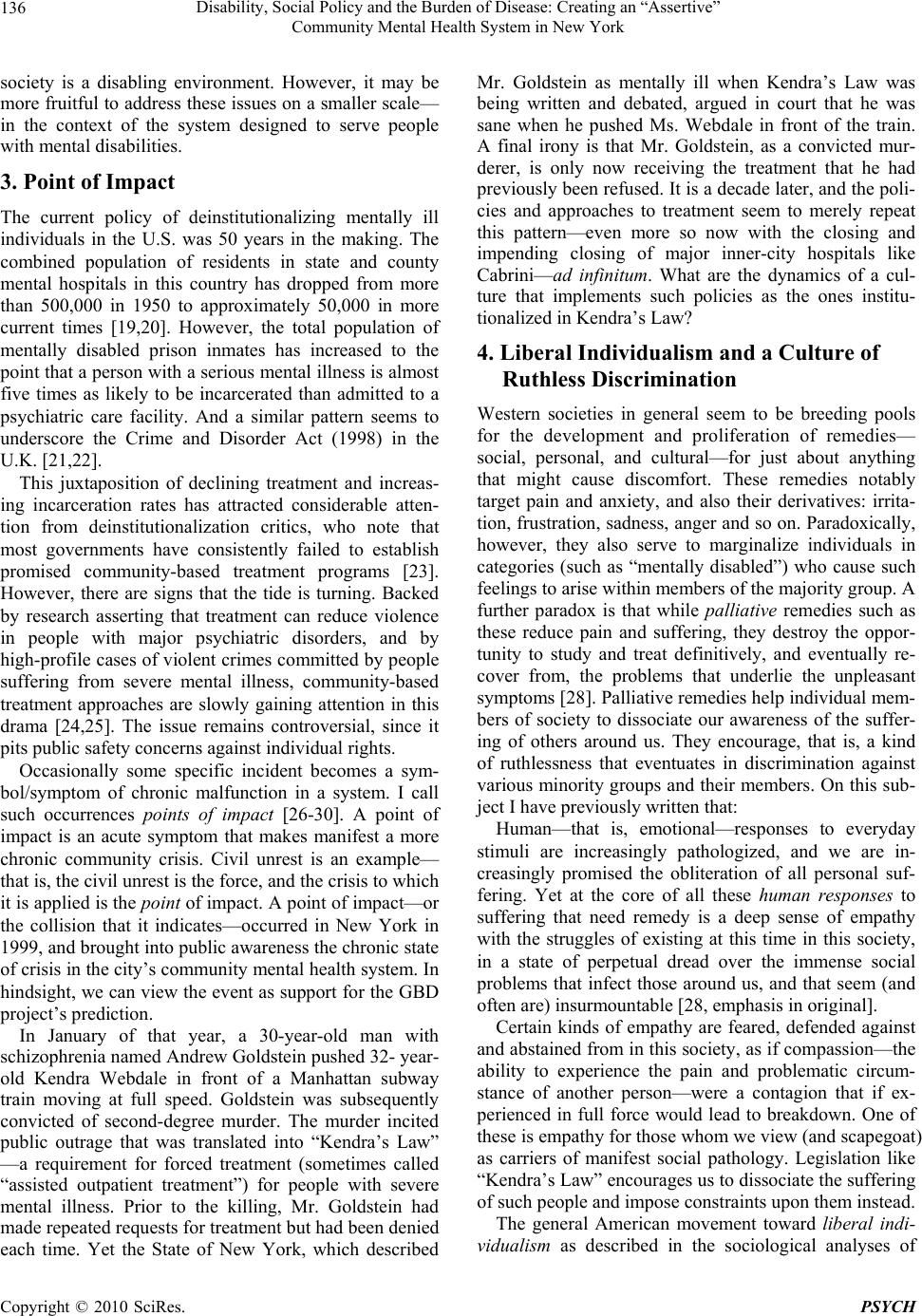 Disability, Social Policy and the Burden of Disease: Creating an “Assertive” 136 Community Mental Health System in New York society is a disabling environment. However, it may be more fruitful to address these issues on a smaller scale— in the context of the system designed to serve people with mental disabilities. 3. Point of Impact The current policy of deinstitutionalizing mentally ill individuals in the U.S. was 50 years in the making. The combined population of residents in state and county mental hospitals in this country has dropped from more than 500,000 in 1950 to approximately 50,000 in more current times [19,20]. However, the total population of mentally disabled prison inmates has increased to the point that a person with a seriou s mental illness is almost five times as likely to be incarcerated than admitted to a psychiatric care facility. And a similar pattern seems to underscore the Crime and Disorder Act (1998) in the U.K. [21,22] . This juxtaposition of declining treatment and increas- ing incarceration rates has attracted considerable atten- tion from deinstitutionalization critics, who note that most governments have consistently failed to establish promised community-based treatment programs [23]. However, there are signs that the tide is turning. Backed by research asserting that treatment can reduce violence in people with major psychiatric disorders, and by high-profile cases of violent crimes committed by people suffering from severe mental illness, community-based treatment approaches are slowly gaining attention in this drama [24,25]. The issue remains controversial, since it pits public safety concerns against individual rights. Occasionally some specific incident becomes a sym- bol/symptom of chronic malfunction in a system. I call such occurrences points of impact [26-30]. A point of impact is an acute symptom that makes manifest a more chronic community crisis. Civil unrest is an example— that is, the civil unrest is the force, and the crisis to which it is applied is the point of impact. A point of impact—or the collision that it indicates—occurred in New York in 1999, and brough t into public awareness the chronic state of crisis in the city’s community mental health system. In hindsight, we can view the event as support for the G BD project’s predi c t i on. In January of that year, a 30-year-old man with schizophrenia named Andrew Goldstein pushed 32- year- old Kendra Webdale in front of a Manhattan subway train moving at full speed. Goldstein was subsequently convicted of second-degree murder. The murder incited public outrage that was translated into “Kendra’s Law” —a requirement for forced treatment (sometimes called “assisted outpatient treatment”) for people with severe mental illness. Prior to the killing, Mr. Goldstein had made repeated requests for treatment but had been denied each time. Yet the State of New York, which described Mr. Goldstein as mentally ill when Kendra’s Law was being written and debated, argued in court that he was sane when he pushed Ms. Webdale in front of the train. A final irony is that Mr. Goldstein, as a convicted mur- derer, is only now receiving the treatment that he had previously b een refused . It is a decade later, and the poli- cies and approaches to treatment seem to merely repeat this pattern—even more so now with the closing and impending closing of major inner-city hospitals like Cabrini—ad infinitum. What are the dynamics of a cul- ture that implements such policies as the ones institu- tionalized in Kendra’s Law? 4. Liberal Individualism and a Culture of Ruthless Discrimination Western societies in general seem to be breeding pools for the development and proliferation of remedies— social, personal, and cultural—for just about anything that might cause discomfort. These remedies notably target pain and anxiety, and also their derivatives: irrita- tion, frustration, sadness, anger and so on. Paradoxically, however, they also serve to marginalize individuals in categories (such as “mentally disabled”) who cause such feelings to arise within members of the majority group. A further paradox is that while palliative remedies such as these reduce pain and suffering, they destroy the oppor- tunity to study and treat definitively, and eventually re- cover from, the problems that underlie the unpleasant symptoms [28]. Palliative remedies help individual mem- bers of society to dissociate our awareness of the suffer- ing of others around us. They encourage, that is, a kind of ruthlessness that eventuates in discrimination against various minority groups and their members. On this sub- ject I have previously written that: Human—that is, emotional—responses to everyday stimuli are increasingly pathologized, and we are in- creasingly promised the obliteration of all personal suf- fering. Yet at the core of all these human responses to suffering that need remedy is a deep sense of empathy with the struggles of existing at this time in this society, in a state of perpetual dread over the immense social problems that infect those around us, and that seem (and often are) insurmountable [28, emphasis in original]. Certain kinds of empathy are feared, defended against and abstained from in this society, as if compassion—the ability to experience the pain and problematic circum- stance of another person—were a contagion that if ex- perienced in full force would lead to breakdown. One of these is empathy for those whom we view (and scapegoat) as carriers of manifest social pathology. Legislation like “Kendra’s Law” encourages us to dissociate the suffering of such people and impose constraints upon them instead. The general American movement toward liberal indi- vidualism as described in the sociological analyses of Copyright © 2010 SciRes. PSYCH  Disability, Social Policy and the Burden of Disease: Creating an “Assertive” 137 Community Mental Health System in New York Bellah, Madsen, Sullivan, Swindler and Tipton [31] sup- ports the Kendra’s Law mentality. Bellah and colleagues asserted that the definitive aim of life in a liberal, indi- vidualistic society is to promote fulfillment (increased satisfaction and decreased discomfort) for individuals, rather than groups or communities. By individualizing fulfillment and satisfaction, people in such cultures are perfectly set up to ignore and are supported in the prac- tice of ignoring, or dissociating the suffering of others. That is, enacting a ruthless discrimination as a status quo approach to living, making massive categorical biases seem necessary. The underside of the argument pre- sented by Bellah and others, such as Amitai Etzioni [32] is that such arguments pose a kind of “new communi- tarianism” that defines community as prior to individual rights and a call for a return to traditional social institu- tions such as religion and the family [33,34]. The new communitarians largely uphold the liberal Western tradi- tion, criticizing deviation s or threats to this tradition [35]. Yet in this process, they wind up repeating the elitist un- derpinning of the very system they criticize, and becom- ing the watchdogs of their own version of the “good life.” The pervasiveness of the liberal individualism per- spective has been analyzed in many of the social and cultural institutions in capitalist societies, particularly the United States. The mental health machinery of this coun- try has attracted special interest [36,37]. In fact, some authors have specified a sense that the ways in which the major critiques of liberal individualism themselves have been framed supports a kind of “America as Empire” philosophy [38-40] that overlooks crucial issues related to race, class and gender bias [1,41-43] as well as ableism. The dynamics of discrimination that underlie liberal individualism can be seen as a societal-level character defense that allows us to avoid acknowledging the social consequences of a belief system that supports fulfillment for some and suffering for others. As this belief system rigidifies, it begins to function as an ideology. By ideol- ogy I mean “those values and assumptions about the world which have implicatio ns for th e con trol and allo ca- tion of limited resources” [44]. Problems and fulfillments are increasingly individualized, separated from their so- cial and cultural influences and etiologies, and the re- sulting control and allocation processes are dissociated [2,45]. The inability or unwillingness to empathize with both self and other diminishes the likelihood that subver- sive or revolutionary processes will exert any impact on society’s daily functions, let alone accomplish any sig- nificant social transformations. When (individual, group or community) awareness of pain and suffering is reduced through the use of sanc- tioned group-level discrimination, what remains is a form of chronic crisis so muffled that even those in the middle of it may not perceive it. This process not only supports a “victim-blaming ideology” [46]. It also establishes a framework for defining social problems in terms of so- cial conditions (e.g., poverty, racism, poor healthcare) and the groups that allegedly engender them [47,48]. The dynamics of ruthlessness concretize th e split between the subjectified self and the objectified (or “inanimate”) other [13,49,50]. I will now discuss an ongoing social justice project that has attempted to address some of the underlyi ng pr o bl ems associated with these dynamics. 5. Community Response and the Development of a Responsive Social Policy The Coalition of Voluntary Mental Health Agencies (the Coalition) consid ers that its primary task is to ensure th at New York’s community mental health care system pro- vides adequate care for the people it is meant to serve. The Coalition’s member agencies serve more than 250,000 clients in almost all the communities and neighborhoods of our country’s most diverse city. The Coalition is a child of deinstitutionalization. New York State began its deinstitutionalization program in part because advocates and policy makers recognized that people with mental illness deserved better than to languish in huge, impersonal hospitals. Deinstitutionali- zation implied not only fiscal savings, but also a promise —still unfulfilled—that clients discharged from psychi- atric hospitals would receive adequate care upon their return to their communities. The Coalition was born to address the failure of communities to p rovide that care. Toward the end of January 1999, the Coalition held a meeting to address the issues raised by the Webdale/ Goldstein tragedy. Its spokesperson and executive direc- tor, Phillip Saperia, claimed that: For Andr ew Golds tein, it se ems we tra ded a hu ge state hospital for an 8 × 10 basement room along with alter- nating hospital readmission and outpatient clinic treat- ment. Andrew is not blameless in this tragedy, but nei- ther is the State of New York. This was not, as some have suggested, an act so random as to be unavoidable. While we cannot prev ent ev ery traged y, we k now how to guard against catastrophes like this one. We know that integrated, assertive, coordinated community-based treat- ment works. We know that discharging someone from a hospital without a discharge plan to a lonely basement apartment with little professional suppo rt, onsite services or crisis intervention does not work [51]. The Webdale/Goldstein tragedy is but one of the cases the Coalition has used to shed light on critical issues af- fecting adequate treatment, service delivery and policy for people with mental disabilities. The Coalition serves as a vocal advocate for adequate care and the realistic resources—especially legislative— required to provide it. Funding is a major community mental health service issue in New York State, as it is throughout the country; Copyright © 2010 SciRes. PSYCH 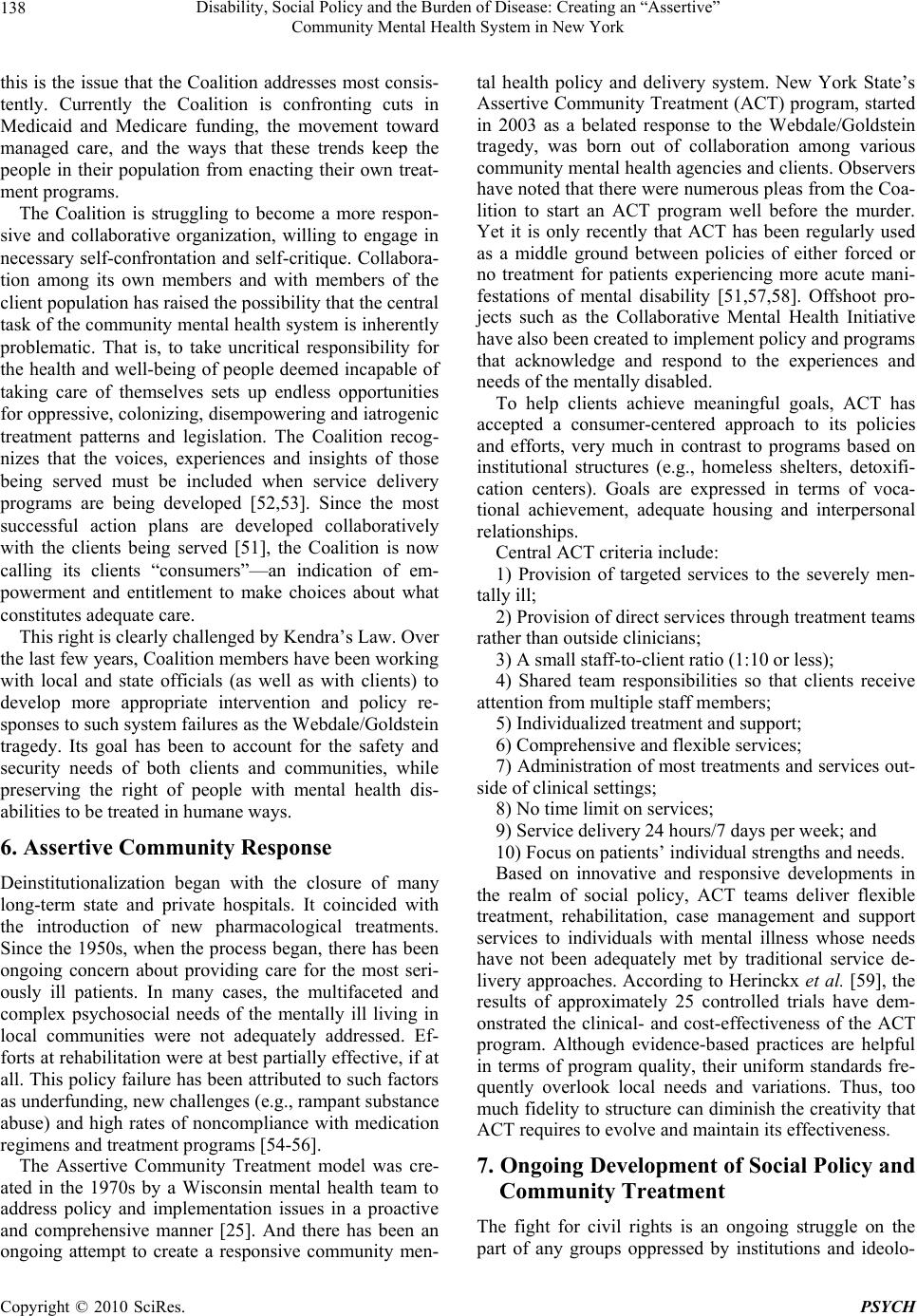 Disability, Social Policy and the Burden of Disease: Creating an “Assertive” 138 Community Mental Health System in New York this is the issue that the Co alition addresses most consis- tently. Currently the Coalition is confronting cuts in Medicaid and Medicare funding, the movement toward managed care, and the ways that these trends keep the people in their population from enacting their own treat- ment programs. The Coalition is struggling to become a more respon- sive and collaborative organization, willing to engage in necessary self-confrontation and self-critique. Collabora- tion among its own members and with members of the client population h as raised the possibility that th e cen tral task of the community mental health system is inh erently problematic. That is, to take uncritical responsibility for the health and well-being of people deemed incapable of taking care of themselves sets up endless opportunities for oppressive, colonizing, disempowering and iatrogenic treatment patterns and legislation. The Coalition recog- nizes that the voices, experiences and insights of those being served must be included when service delivery programs are being developed [52,53]. Since the most successful action plans are developed collaboratively with the clients being served [51], the Coalition is now calling its clients “consumers”—an indication of em- powerment and entitlement to make choices about what constitutes adequ ate care. This right is clearly challenged by Kendra’s Law. Over the last few years, Coalition members have been working with local and state officials (as well as with clients) to develop more appropriate intervention and policy re- sponses to such system failures as the W ebdale/Goldstein tragedy. Its goal has been to account for the safety and security needs of both clients and communities, while preserving the right of people with mental health dis- abilities to be treated in humane ways. 6. Assertive Community Response Deinstitutionalization began with the closure of many long-term state and private hospitals. It coincided with the introduction of new pharmacological treatments. Since the 1950s, when the process began, there has been ongoing concern about providing care for the most seri- ously ill patients. In many cases, the multifaceted and complex psychosocial needs of the mentally ill living in local communities were not adequately addressed. Ef- forts at rehabilitation were at best partially effective, if at all. This policy failure has been attributed to such factors as underfunding, new challenges (e.g., rampant substance abuse) and high rates of noncompliance with medication regimens and treatment programs [54-56]. The Assertive Community Treatment model was cre- ated in the 1970s by a Wisconsin mental health team to address policy and implementation issues in a proactive and comprehensive manner [25]. And there has been an ongoing attempt to create a responsive community men- tal health policy and delivery system. New York State’s Assertive Community Treatment (ACT) program, started in 2003 as a belated response to the Webdale/Goldstein tragedy, was born out of collaboration among various community mental health agencies and clients. Observers have noted that there were numerous pleas from the Coa- lition to start an ACT program well before the murder. Yet it is only recently that ACT has been regularly used as a middle ground between policies of either forced or no treatment for patients experiencing more acute mani- festations of mental disability [51,57,58]. Offshoot pro- jects such as the Collaborative Mental Health Initiative have also been created to implement policy and programs that acknowledge and respond to the experiences and needs of the mentally disabled. To help clients achieve meaningful goals, ACT has accepted a consumer-centered approach to its policies and efforts, very much in contrast to programs based on institutional structures (e.g., homeless shelters, detoxifi- cation centers). Goals are expressed in terms of voca- tional achievement, adequate housing and interpersonal relationships. Central ACT criteria include: 1) Provision of targeted services to the severely men- tally ill; 2) Provision of direct services th rough treatment teams rather than outside clinicians; 3) A small staff-to-client ratio (1:10 or less); 4) Shared team responsibilities so that clients receive attention from multiple staff members; 5) Individualized treatment and support; 6) Comprehensive and flexible services; 7) Administration of most treatments and services out- side of clinical settings; 8) No time limit on services; 9) Service delivery 24 hours/7 days per week; and 10) Focus on patients’ individual strengths and needs. Based on innovative and responsive developments in the realm of social policy, ACT teams deliver flexible treatment, rehabilitation, case management and support services to individuals with mental illness whose needs have not been adequately met by traditional service de- livery approaches. According to Herinckx et al. [59], the results of approximately 25 controlled trials have dem- onstrated the clinical- and cost-effectiveness of the ACT program. Although evidence-based practices are helpful in terms of program quality, their uniform standards fre- quently overlook local needs and variations. Thus, too much fidelity to structure can diminish th e creativity that ACT requires to evolve and maintain its effectiveness. 7. Ongoing Development of Social Policy and Community Treatment The fight for civil rights is an ongoing struggle on the part of any groups oppressed by institutions and ideolo- Copyright © 2010 SciRes. PSYCH 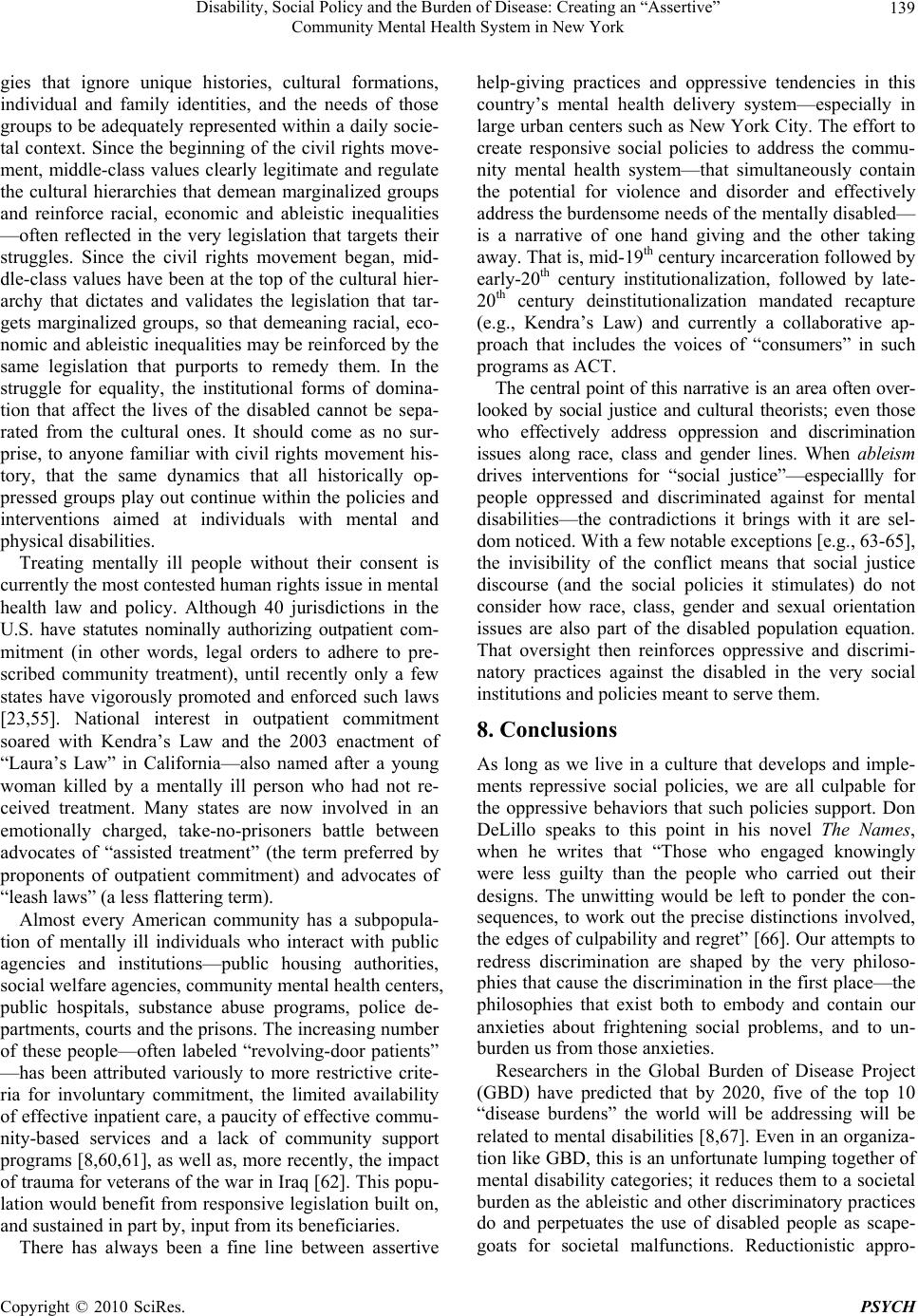 Disability, Social Policy and the Burden of Disease: Creating an “Assertive” 139 Community Mental Health System in New York gies that ignore unique histories, cultural formations, individual and family identities, and the needs of those groups to be adequately rep resented within a daily socie- tal context. Since the beginning of the civil rights move- ment, middle-class values clearly legitimate and regulate the cultural hierarchies that demean marginalized groups and reinforce racial, economic and ableistic inequalities —often reflected in the very legislation that targets their struggles. Since the civil rights movement began, mid- dle-class values have been at the top of the cultural hier- archy that dictates and validates the legislation that tar- gets marginalized groups, so that demeaning racial, eco- nomic and ableistic inequ alities may be reinforced by the same legislation that purports to remedy them. In the struggle for equality, the institutional forms of domina- tion that affect the lives of the disabled cannot be sepa- rated from the cultural ones. It should come as no sur- prise, to anyone familiar with civil rights movement his- tory, that the same dynamics that all historically op- pressed groups play out continue within the policies and interventions aimed at individuals with mental and physical disabilities. Treating mentally ill people without their consent is currently the most co ntested human rights issu e in mental health law and policy. Although 40 jurisdictions in the U.S. have statutes nominally authorizing outpatient com- mitment (in other words, legal orders to adhere to pre- scribed community treatment), until recently only a few states have vigorously promoted and enforced such laws [23,55]. National interest in outpatient commitment soared with Kendra’s Law and the 2003 enactment of “Laura’s Law” in California—also named after a young woman killed by a mentally ill person who had not re- ceived treatment. Many states are now involved in an emotionally charged, take-no-prisoners battle between advocates of “assisted treatment” (the term preferred by proponents of outpatient commitment) and advocates of “leash laws” (a less flattering term). Almost every American community has a subpopula- tion of mentally ill individuals who interact with public agencies and institutions—public housing authorities, social welfare agencies, community mental health centers, public hospitals, substance abuse programs, police de- partments, courts and the prisons. The increasing number of these people—often labeled “revolving-door patients” —has been attributed variously to more restrictive crite- ria for involuntary commitment, the limited availability of effective inpatient care, a paucity of effective commu- nity-based services and a lack of community support programs [8,60,61], as well as, more recently, the impact of trauma for veterans of the war in Iraq [62]. This popu- lation would benefit fro m responsive leg islation built on, and sustained in part by, input from its beneficiaries. There has always been a fine line between assertive help-giving practices and oppressive tendencies in this country’s mental health delivery system—especially in large urban centers such as New York City. The effort to create responsive social policies to address the commu- nity mental health system—that simultaneously contain the potential for violence and disorder and effectively address the burdensome needs of the mentally disabled— is a narrative of one hand giving and the other taking away. That is, mid- 19th century incarceration followed by early-20th century institutionalization, followed by late- 20th century deinstitutionalization mandated recapture (e.g., Kendra’s Law) and currently a collaborative ap- proach that includes the voices of “consumers” in such programs as ACT. The central point of this narrative is an area often over- looked by social justice and cultural theorists; even those who effectively address oppression and discrimination issues along race, class and gender lines. When ableism drives interventions for “social justice”—especiallly for people oppressed and discriminated against for mental disabilities—the contradictions it brings with it are sel- dom noticed. With a few notable exceptions [e.g., 63-65], the invisibility of the conflict means that social justice discourse (and the social policies it stimulates) do not consider how race, class, gender and sexual orientation issues are also part of the disabled population equation. That oversight then reinforces oppressive and discrimi- natory practices against the disabled in the very social institutions and policies meant to serve them. 8. Conclusions As long as we live in a culture that develops and imple- ments repressive social policies, we are all culpable for the oppressive behaviors that such policies support. Don DeLillo speaks to this point in his novel The Names, when he writes that “Those who engaged knowingly were less guilty than the people who carried out their designs. The unwitting would be left to ponder the con- sequences, to work out the precise distinctions involved, the edges of culpab ility and regret” [66]. Our attempts to redress discrimination are shaped by the very philoso- phies that cause the discrimination in the first place—the philosophies that exist both to embody and contain our anxieties about frightening social problems, and to un- burden us from those anxieties. Researchers in the Global Burden of Disease Project (GBD) have predicted that by 2020, five of the top 10 “disease burdens” the world will be addressing will be related to mental disabilities [8,67 ]. Even in an organiza- tion like GBD, this is an unfortunate lu mping together of mental disability categories; it reduces them to a societal burden as the ableistic and o ther discriminatory practices do and perpetuates the use of disabled people as scape- goats for societal malfunctions. Reductionistic appro- Copyright © 2010 SciRes. PSYCH 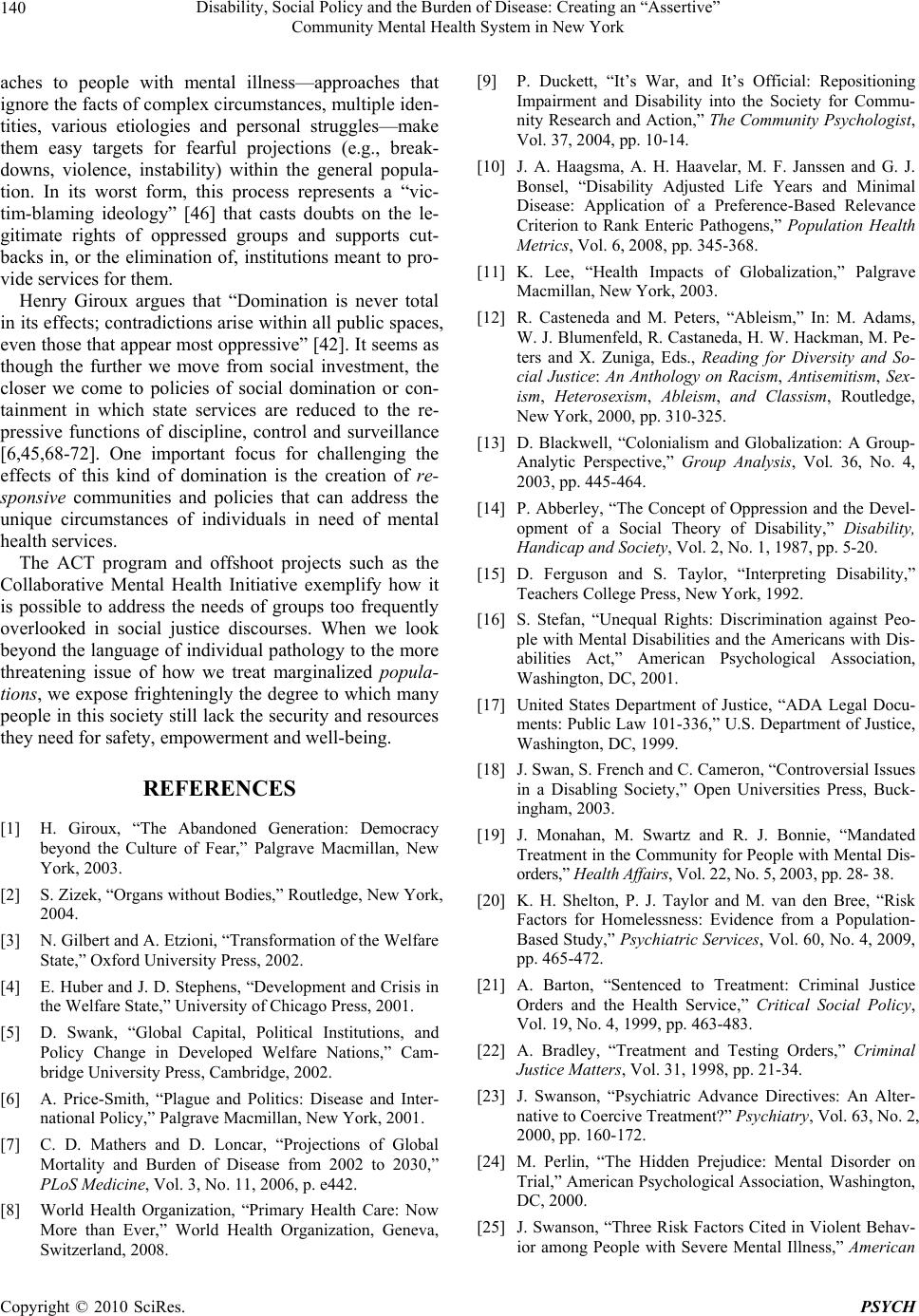 Disability, Social Policy and the Burden of Disease: Creating an “Assertive” 140 Community Mental Health System in New York aches to people with mental illness—approaches that ignore the facts of complex circumstances, multiple iden- tities, various etiologies and personal struggles—make them easy targets for fearful projections (e.g., break- downs, violence, instability) within the general popula- tion. In its worst form, this process represents a “vic- tim-blaming ideology” [46] that casts doubts on the le- gitimate rights of oppressed groups and supports cut- backs in, or the elimination of, institutions meant to pro- vide services for them. Henry Giroux argues that “Domination is never total in its effects; contradictions arise within all public spaces, even those that appear most oppressive” [42]. It seems as though the further we move from social investment, the closer we come to policies of social domination or con- tainment in which state services are reduced to the re- pressive functions of discipline, control and surveillance [6,45,68-72]. One important focus for challenging the effects of this kind of domination is the creation of re- sponsive communities and policies that can address the unique circumstances of individuals in need of mental health services. The ACT program and offshoot projects such as the Collaborative Mental Health Initiative exemplify how it is possible to address the needs of groups too frequently overlooked in social justice discourses. When we look beyond the lang uage of individual pathology to the mor e threatening issue of how we treat marginalized popula- tions, we expose frighteningly the degree to which many people in this society still lack the secu rity and resources they need for safety, empowerment and well-being. REFERENCES [1] H. Giroux, “The Abandoned Generation: Democracy beyond the Culture of Fear,” Palgrave Macmillan, New York, 2003. [2] S. Zizek, “Organs without Bodies,” Routledge, New York, 2004. [3] N. Gilbert and A. Etzioni, “Transformation of the Welfare State,” Oxford University Press, 2002. [4] E. Huber and J. D. Stephens, “Development and Crisis in the Welfare State,” University of Chicago Press, 2001. [5] D. Swank, “Global Capital, Political Institutions, and Policy Change in Developed Welfare Nations,” Cam- bridge University Press, Cambridge, 2002. [6] A. Price-Smith, “Plague and Politics: Disease and Inter- national Policy,” Palgrave Macmillan, New York, 2001. [7] C. D. Mathers and D. Loncar, “Projections of Global Mortality and Burden of Disease from 2002 to 2030,” PLoS Medicine, Vol. 3, No. 11, 2006, p. e442. [8] World Health Organization, “Primary Health Care: Now More than Ever,” World Health Organization, Geneva, Switzerland, 2008. [9] P. Duckett, “It’s War, and It’s Official: Repositioning Impairment and Disability into the Society for Commu- nity Research and Action,” The Community Psychologist, Vol. 37, 2004, pp. 10-14. [10] J. A. Haagsma, A. H. Haavelar, M. F. Janssen and G. J. Bonsel, “Disability Adjusted Life Years and Minimal Disease: Application of a Preference-Based Relevance Criterion to Rank Enteric Pathogens,” Population Health Metrics, Vol. 6, 2008, pp. 345-368. [11] K. Lee, “Health Impacts of Globalization,” Palgrave Macmillan, New York, 2003. [12] R. Casteneda and M. Peters, “Ableism,” In: M. Adams, W. J. Blumenfeld, R. Castaneda, H. W. Hackman, M. Pe- ters and X. Zuniga, Eds., Reading for Diversity and So- cial Justice: An Anthology on Racism, Antisemitism, Sex- ism, Heterosexism, Ableism, and Classism, Routledge, New York, 2000, pp. 310-325. [13] D. Blackwell, “Colonialism and Globalization: A Group- Analytic Perspective,” Group Analysis, Vol. 36, No. 4, 2003, pp. 445-464. [14] P. Abberley, “The Concept of Oppression and the Devel- opment of a Social Theory of Disability,” Disability, Handicap and Society, Vol. 2, No. 1, 1987, pp. 5-20. [15] D. Ferguson and S. Taylor, “Interpreting Disability,” Teachers College Press, New York, 1992. [16] S. Stefan, “Unequal Rights: Discrimination against Peo- ple with Mental Disabilities and the Americans with Dis- abilities Act,” American Psychological Association, Washington, DC, 2001. [17] United States Department of Justice, “ADA Legal Docu- ments: Public Law 101-336,” U.S. Department of Justice, Washington, DC, 1999. [18] J. Swan, S. French and C. Cameron, “Controversial Issues in a Disabling Society,” Open Universities Press, Buck- ingham, 2003. [19] J. Monahan, M. Swartz and R. J. Bonnie, “Mandated Treatment in the Community for People with Mental Dis- orders,” Health Affairs, Vol. 22, No. 5, 2003, pp. 28- 38. [20] K. H. Shelton, P. J. Taylor and M. van den Bree, “Risk Factors for Homelessness: Evidence from a Population- Based Study,” Psychiatric Services, Vol. 60, No. 4, 2009, pp. 465-472. [21] A. Barton, “Sentenced to Treatment: Criminal Justice Orders and the Health Service,” Critical Social Policy, Vol. 19, No. 4, 1999, pp. 463-483. [22] A. Bradley, “Treatment and Testing Orders,” Criminal Justice Matters, Vol. 31, 1998, pp. 21-34. [23] J. Swanson, “Psychiatric Advance Directives: An Alter- native to Coercive Treatment?” Psychiatry, Vol. 63, No. 2, 2000, pp. 160-172. [24] M. Perlin, “The Hidden Prejudice: Mental Disorder on Trial,” American Psychological Association, Washington, DC, 2000. [25] J. Swanson, “Three Risk Factors Cited in Violent Behav- ior among People with Severe Mental Illness,” American Copyright © 2010 SciRes. PSYCH 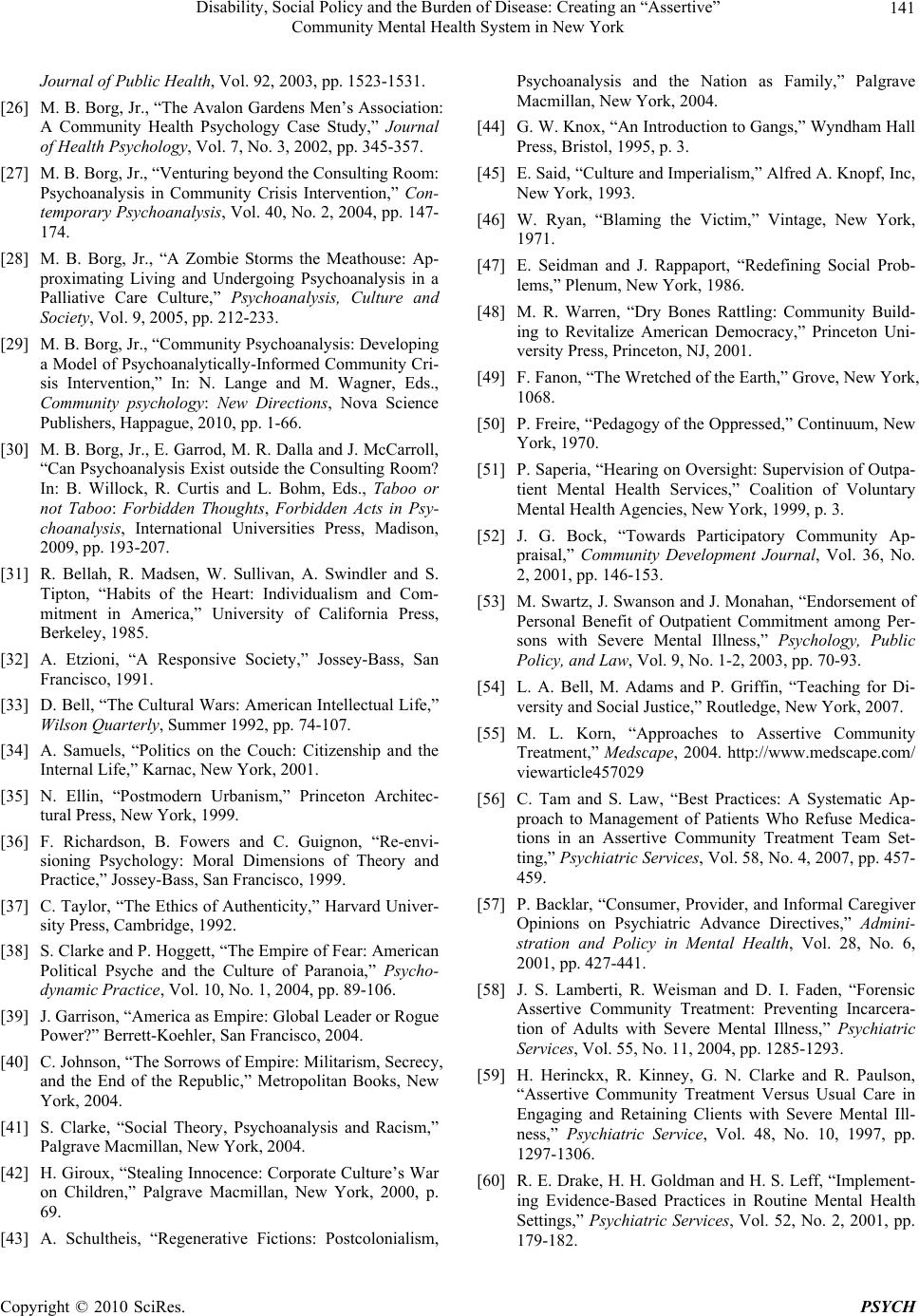 Disability, Social Policy and the Burden of Disease: Creating an “Assertive” 141 Community Mental Health System in New York Journal of Public Health, Vol. 92, 2003, pp. 1523-1531. [26] M. B. Borg, Jr., “The Avalon Gardens Men’s Association: A Community Health Psychology Case Study,” Journal of Health Psychology, Vol. 7, No. 3, 2002, pp. 345-357. [27] M. B. Borg, Jr., “Venturing beyond the Consulting Room: Psychoanalysis in Community Crisis Intervention,” Con- temporary Psychoanalysis, Vol. 40, No. 2, 2004, pp. 147- 174. [28] M. B. Borg, Jr., “A Zombie Storms the Meathouse: Ap- proximating Living and Undergoing Psychoanalysis in a Palliative Care Culture,” Psychoanalysis, Culture and Society, Vol. 9, 2005, pp. 212-233. [29] M. B. Borg, Jr., “Community Psychoanalysis: Developing a Model of Psychoanalytically-Informed Community Cri- sis Intervention,” In: N. Lange and M. Wagner, Eds., Community psychology: New Directions, Nova Science Publishers, Happague, 2010, pp. 1-66. [30] M. B. Borg, Jr., E. Garrod, M. R. Dalla and J. McCarroll, “Can Psychoanalysis Exist outside the Consulting Room? In: B. Willock, R. Curtis and L. Bohm, Eds., Taboo or not Taboo: Forbidden Thoughts, Forbidden Acts in Psy- choanalysis, International Universities Press, Madison, 2009, pp. 193-207. [31] R. Bellah, R. Madsen, W. Sullivan, A. Swindler and S. Tipton, “Habits of the Heart: Individualism and Com- mitment in America,” University of California Press, Berkeley, 1985. [32] A. Etzioni, “A Responsive Society,” Jossey-Bass, San Francisco, 1991. [33] D. Bell, “The Cultural Wars: American Intellectual Life,” Wilson Quarterly, Summer 1992, pp. 74-107. [34] A. Samuels, “Politics on the Couch: Citizenship and the Internal Life,” Karnac, New York, 2001. [35] N. Ellin, “Postmodern Urbanism,” Princeton Architec- tural Press, New York, 1999. [36] F. Richardson, B. Fowers and C. Guignon, “Re-envi- sioning Psychology: Moral Dimensions of Theory and Practice,” Jossey-Bass, San Francisco, 1999. [37] C. Taylor, “The Ethics of Authenticity,” Harvard Univer- sity Press, Cambridge, 1992. [38] S. Clarke and P. Hoggett, “The Empire of Fear: American Political Psyche and the Culture of Paranoia,” Psycho- dynamic Practice, Vol. 10, No. 1, 2004, pp. 89-106. [39] J. Garrison, “America as Empire: Global Leader or Rogue Power?” Berrett-Koehler, San Francisco, 2004. [40] C. Johnson, “The Sorrows of Empire: Militarism, Secrecy, and the End of the Republic,” Metropolitan Books, New York, 2004. [41] S. Clarke, “Social Theory, Psychoanalysis and Racism,” Palgrave Macmillan, New York, 2004. [42] H. Giroux, “Stealing Innocence: Corporate Culture’s War on Children,” Palgrave Macmillan, New York, 2000, p. 69. [43] A. Schultheis, “Regenerative Fictions: Postcolonialism, Psychoanalysis and the Nation as Family,” Palgrave Macmillan, New York, 2004. [44] G. W. Knox, “An Introduction to Gangs,” Wyndham Hall Press, Bristol, 1995, p. 3. [45] E. Said, “Culture and Imperialism,” Alfred A. Knopf, Inc, New York, 1993. [46] W. Ryan, “Blaming the Victim,” Vintage, New York, 1971. [47] E. Seidman and J. Rappaport, “Redefining Social Prob- lems,” Plenum, New York, 1986. [48] M. R. Warren, “Dry Bones Rattling: Community Build- ing to Revitalize American Democracy,” Princeton Uni- versity Press, Princeton, NJ, 2001. [49] F. Fanon, “The Wretched of the Earth,” Grove, New York, 1068. [50] P. Freire, “Pedagogy of the Oppressed,” Continuum, New York, 1970. [51] P. Saperia, “Hearing on Oversight: Supervision of Outpa- tient Mental Health Services,” Coalition of Voluntary Mental Health Agencies, New York, 1999, p. 3. [52] J. G. Bock, “Towards Participatory Community Ap- praisal,” Community Development Journal, Vol. 36, No. 2, 2001, pp. 146-153. [53] M. Swartz, J. Swanson an d J. Monahan, “Endorsement of Personal Benefit of Outpatient Commitment among Per- sons with Severe Mental Illness,” Psychology, Public Policy, and Law, Vol. 9, No. 1-2, 2003, pp. 70-93. [54] L. A. Bell, M. Adams and P. Griffin, “Teaching for Di- versity and Social Justice,” Routledge, New York, 2007. [55] M. L. Korn, “Approaches to Assertive Community Treatment,” Medscape, 2004. http://www.medscape.com/ viewarticle457029 [56] C. Tam and S. Law, “Best Practices: A Systematic Ap- proach to Management of Patients Who Refuse Medica- tions in an Assertive Community Treatment Team Set- ting,” Psychiatric Services, Vol. 58, No. 4, 2007, pp. 457- 459. [57] P. Backlar, “Consumer, Provi der, and Informal Caregiver Opinions on Psychiatric Advance Directives,” Admini- stration and Policy in Mental Health, Vol. 28, No. 6, 2001, pp. 427-441. [58] J. S. Lamberti, R. Weisman and D. I. Faden, “Forensic Assertive Community Treatment: Preventing Incarcera- tion of Adults with Severe Mental Illness,” Psychiatric Services, Vol. 55, No. 11, 2004, pp. 1285-1293. [59] H. Herinckx, R. Kinney, G. N. Clarke and R. Paulson, “Assertive Community Treatment Versus Usual Care in Engaging and Retaining Clients with Severe Mental Ill- ness,” Psychiatric Service, Vol. 48, No. 10, 1997, pp. 1297-1306. [60] R. E. Drake, H. H. Goldman and H. S. Leff, “Imple ment- ing Evidence-Based Practices in Routine Mental Health Settings,” Psychiatric Services, Vol. 52, No. 2, 2001, pp. 179-182. Copyright © 2010 SciRes. PSYCH 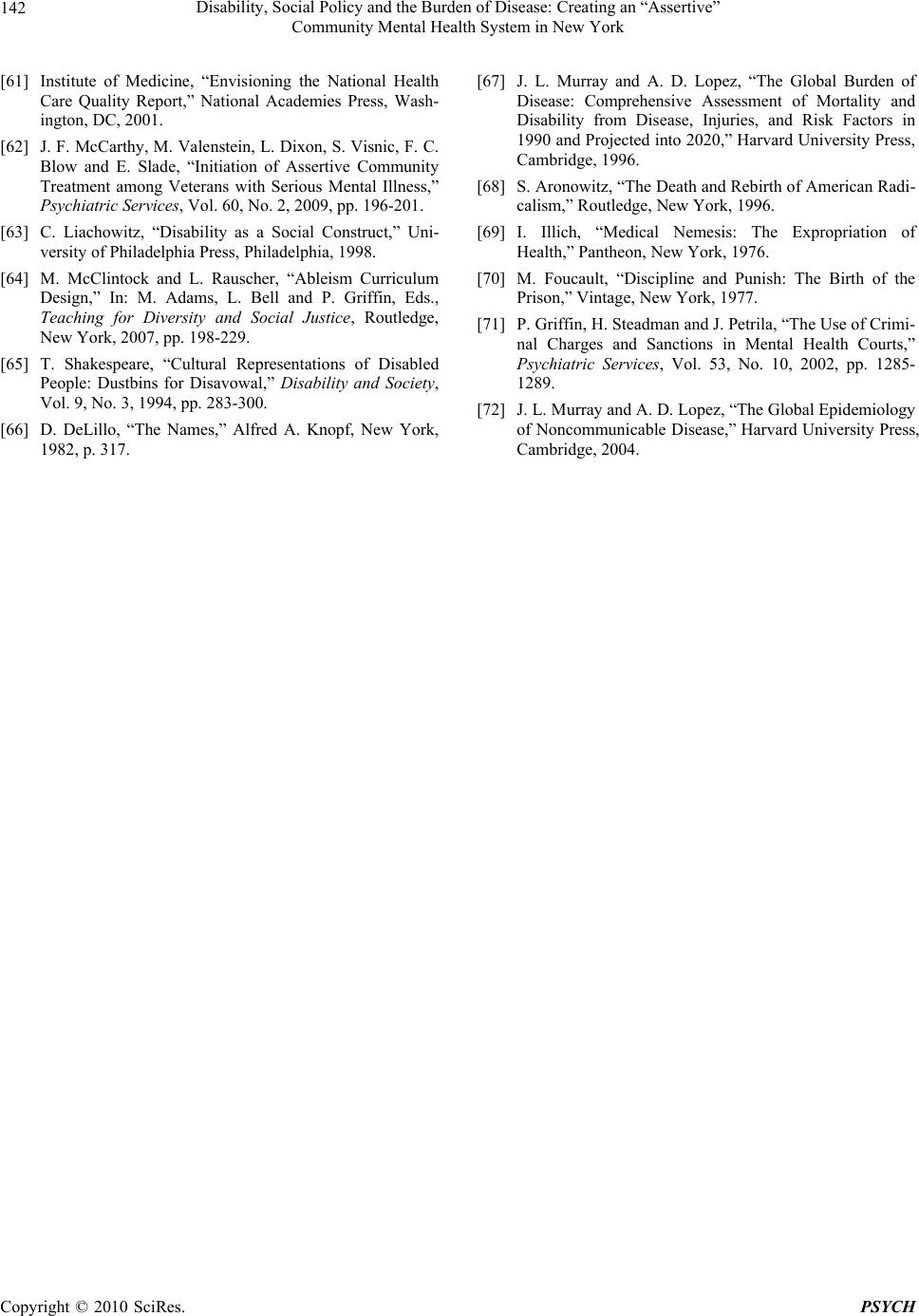 Disability, Social Policy and the Burden of Disease: Creating an “Assertive” Community Mental Health System in New York Copyright © 2010 SciRes. PSYCH 142 [61] Institute of Medicine, “Envisioning the National Health Care Quality Report,” National Academies Press, Wash- ington, DC, 2001. [62] J. F. McCarthy , M. Valenstein, L. Dixon, S. Visnic, F. C. Blow and E. Slade, “Initiation of Assertive Community Treatment among Veterans with Serious Mental Illness,” Psychiatric Services, Vol. 60, No. 2, 2009, pp. 196-201. [63] C. Liachowitz, “Disability as a Social Construct,” Uni- versity of Philadelphia Press, Philadelphia, 1998. [64] M. McClintock and L. Rauscher, “Ableism Curriculum Design,” In: M. Adams, L. Bell and P. Griffin, Eds., Teaching for Diversity and Social Justice, Routledge, New York, 2007, pp. 198-229. [65] T. Shakespeare, “Cultural Representations of Disabled People: Dustbins for Disavowal,” Disability and Society, Vol. 9, No. 3, 1994, pp. 283-300. [66] D. DeLillo, “The Names,” Alfred A. Knopf, New York, 1982, p. 317. [67] J. L. Murray and A. D. Lopez, “The Global Burden of Disease: Comprehensive Assessment of Mortality and Disability from Disease, Injuries, and Risk Factors in 1990 and Projected into 2020,” Harvard University Press, Cambridge, 1996. [68] S. Aronowitz, “The Death and Rebirth of American Radi- calism,” Routledge, New York, 1996. [69] I. Illich, “Medical Nemesis: The Expropriation of Health,” Pantheon, New York, 1976. [70] M. Foucault, “Discipline and Punish: The Birth of the Prison,” Vintage, New York, 1977. [71] P. Griffin, H. Steadman and J. Petrila, “The Use of Crimi- nal Charges and Sanctions in Mental Health Courts,” Psychiatric Services, Vol. 53, No. 10, 2002, pp. 1285- 1289. [72] J. L. Murray and A. D. Lopez, “The Global Epidemiology of Noncommunicable Disease,” Harvard University Press, Cambridge, 2004. |

